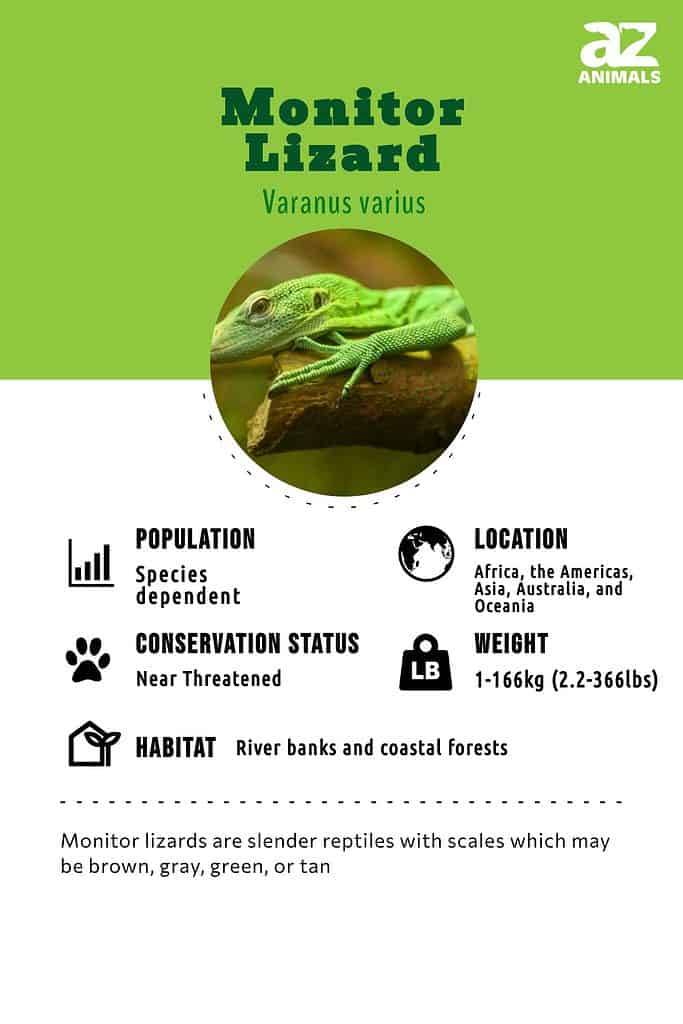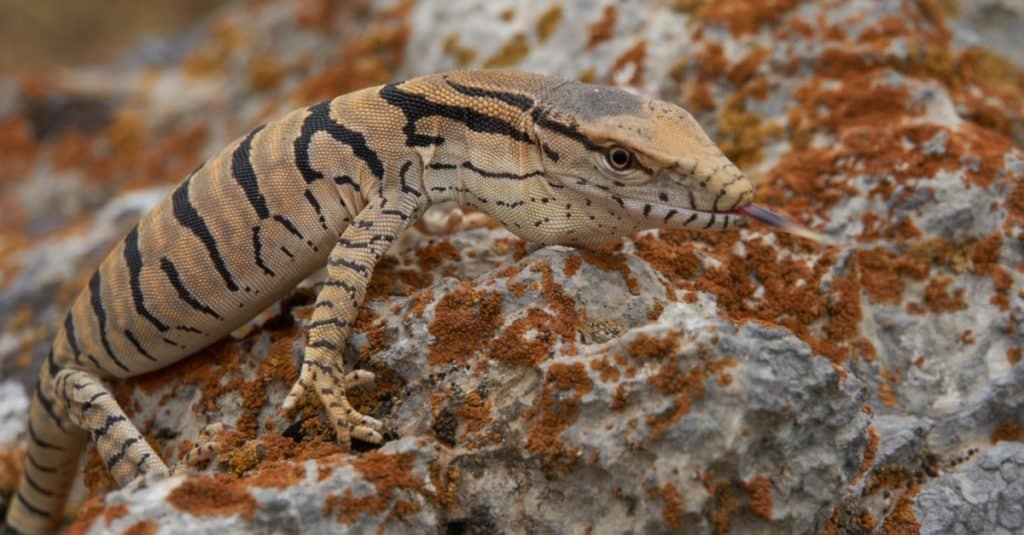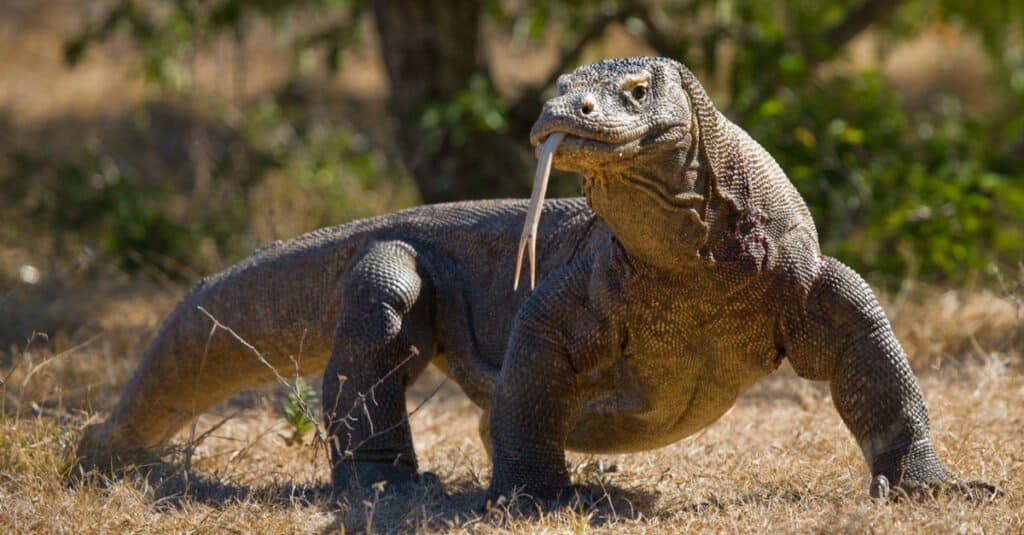Monitor Lizard
Some species are thought to carry a weak venom!
Advertisement
Monitor Lizard Scientific Classification
Read our Complete Guide to Classification of Animals.
Monitor Lizard Conservation Status
Monitor Lizard Facts
- Main Prey
- Rodents, Snakes, Lizards
- Fun Fact
- Some species are thought to carry a weak venom!
- Habitat
- River banks and coastal forests
- Diet
- Carnivore
- Average Litter Size
- 10
- Lifestyle
- Solitary
- Favorite Food
- Rodents
- Type
- Reptile
- Slogan
- Some species are thought to carry a weak venom!
View all of the Monitor Lizard images!
Lizards in the monitor lizard family are among the largest lizards in the world.
These reptiles are mainly native to Asia, Africa, and Australia, but can also be found in parts of the Americas due to the illegal pet trade. Monitor lizards are known for their large claws, powerful tails, long necks, and well-developed legs. They can move quickly and powerfully in pursuit of prey. Most monitor lizards are terrestrial and largely carnivorous. Depending on the size of the lizard, they will eat anything from insects and birds to small mammals.
See all of our expert product reviews.
5 Incredible Monitor Lizard Facts!
- Monitor lizards are considered to be the most intelligent of all lizards and some of the most intelligent reptiles in general.
- Monitors do not blink and they have very good vision. Scientists have observed monitors watching planes in the sky.
- Unlike many other reptiles, many monitor lizards have high metabolisms and burn energy like mammals.
- As pets, monitors have been observed seeking human attention and wanting to play.
- Monitors are alert and skilled predators. As dangerous as they are to smaller animals, their bites are not fatal to humans
Monitor Lizard Scientific name

The monitor lizard belongs to the kingdom Animalia, the phylum Chordata, the class reptilia, the order Squamata, the family Varanidae, and the genus Varanus. There are a number of subgenera for the monitor lizard, including the following:
- Empagusia
- Euprepiosaurus
- Odatria
- Papusaurus
- Philippinosaurus
- Polydaedalus
- Psammosaurus
- Solomonsaurus
- Soterosaurus
- Varanus
The scientific name Varanus comes from an Arabic word that means dragon or lizard beast. The standard English name for the monitor lizard may come from the reptile’s habit of standing on its hind legs to look around.
Types
The genus Varanus consists of a wide range of species. The earless monitor is a rare species of monitor that lives in Borneo. It is the only species in the monitor subfamily Lanthanotinae. It looks much like other monitors with an elongated body, but has smaller limbs than normal.
Examples of other species include:
- Ackies dwarf monitors (Varanus acanthurus): These varanids live in western Australia and are notable for their reddish coloration with cream-colored dots. They are mostly insectivorous although they may nibble on cat or dog food when in captivity. They are capable of growing up to 27 inches long.
- Argus monitors (Varanus panoptes): Capable of growing to 5 feet, they are terrestrial and love to burrow. Although kept as pets, they are not above using their sharp claws to scratch while they attempt to squirm free. They are native to Australia and New Guinea.
- Asian water monitors (Varanus salvator): Second only to the Komodo in size, these varanids are semi-aquatic, and are powerful swimmers. They live among mangroves, swamps, or wetlands, and are capable of growing to 6½ feet.
- Emerald tree monitors (Varanus prasinus): These arboreal monitors are especially popular among pet owners owing to their bright colors. However, they are not above relying on their teeth when they feel frightened. The reptiles are capable of growing to approximately 40 inches.
- Crocodile monitors (Varanus salvadorii): Dark green with yellow spots, these monitors are rather reclusive and are noted for their especially long tails. They live in the rainforests and mangrove swamps of New Guinea and West Papua.
- Gray’s monitors (Varanus olivaceus): Terracotta colored with wide darker bands about their bodies, and a generous sprinkling of yellow spots, these varanids are capable of growing to 6 feet. Arboreal and reclusive, they prefer to eat the fruit of the pandan tree, although they are also partial to crabs, birds, and spiders.
- Nile monitors (Varanus niloticus): Capable of growing to 7 feet, they are the largest varanids in Africa. They live along the Nile and are capable climbers and swift runners. Florida is also home to a feral population of escaped and abandoned monitors which were once pets.
- Peacock monitors (Varanus auffenbergi): Shy and reclusive, these small varanids are colored with thin paler bands and thicker dark bands flecked with turquoise dots. They are capable of growing to 60cm and are excellent climbers.
- Black-throated monitors (Varanus albigularis ionidesi)
- Black tree monitors (Varanus beccarii)
- Dumeril’s monitors (Varanus dumerilii)
- Earless monitor lizard (Lanthanotus borneensis)
- Lace monitors (Varanus varius)
- Mangrove monitors (Varanus indicus)
- Peach-throated monitors (Varanus jobiensis)
- Rock monitors (Varanus albigularis)
- Roughneck monitors (Varanus rudicollis)
- Savannah monitors (Varanus exanthematicus)
- Timor monitors (Varanus timorensis)
Evolution
Experts believe that monitor lizards’ ancestors originated in Asia, based on their discovery of the Archaeovaranus which lived there during the Eocene era between 56 and 33 million years ago.
Health and Entertainment for your Monitor Lizard
See all of our expert product reviews.
It is however worth noting that the Saniwa which was also a varanid and another close cousin, lived in Wyoming 48 million years ago, during the same era. It shared the same traits common to monitors in the present day such as a tail which was nearly double its body length and a finely tapered snout.
However the story of the genus dates as far back as 66 million years ago, or even further, during the Late Cretaceous era, when monitor lizards’ evolutionary branch separated from earless monitors’, who happen to be their closest cousins.
Appearance

©Sergey Dyonin/Shutterstock.com
Types of monitor lizards vary widely in their appearance and size. The smallest species of monitor grows to only eight inches in length. However, several species are quite large and can grow to lengths between seven and ten feet. No matter what size they are, monitor lizards tend to have thick, solid bodies, long necks, well-developed legs, and long tails. Colors vary widely with mottled shades of brown, black, gray, green, yellow, and blue being most common.
Komodo Dragon vs. Monitor Lizard

Komodo dragons are the largest types of monitor lizards and are capable of growing to 10 feet
©GUDKOV ANDREY/Shutterstock.com
The Komodo dragon is actually a type of monitor lizard. Its scientific name is Varanus komodoensis. The Komodo dragon is the largest species of monitor lizard, and it can grow up to ten feet long and weigh 300 pounds. Komodo dragons are also generally known to be the most dangerous types of monitor lizards, and some attacks on humans have been recorded.
Komodo dragons look generally similar to other monitor lizards, but they tend to have larger and heavier frames. Most other types of monitors have a more slender appearance. The skin of a Komodo dragon is also unusual compared to other monitors. It has tiny bones called osteoderms throughout its skin, which reinforces its toughness against predators.
The dragon’s skin is thus very rugged and rough.
Behavior
Monitor lizards are generally solitary reptiles, but in some areas with limited water resources, monitors will gather in groups of up to 25. Otherwise, monitor lizards typically lead solitary lives until they come together to breed. Monitors are mostly terrestrial and move about most comfortably on land — especially with the larger species. There are a few arboreal and aquatic monitor species as well.
Most monitors are completely carnivorous. Monitors generally avoid humans but can be dangerous if provoked. They are faster than they appear and have strong jaws and tails. Monitors can be very aggressive in protecting their territory or food. Many monitors are active hunters that stalk and chase down their prey. Other types of monitors are more interested in scavenging.
Habitat

Some monitor lizards are aquatic, others arboreal, and most, terrestrial
©iStock.com/Vidu Gunaratna
These lizards are readily found in Africa and Asia as well as islands in Oceania. They can now be found in parts of the Americas, but they are considered an invasive species due to their non-native status. Monitor lizards in the Americas originated from the exotic pet trade. Monitor lizards adapt to many environments. They can be found in jungles and rainforests, but also in aquatic areas and hot and dry areas.
Water monitors like the Asian water monitor live in coastal areas with semiaquatic habitats such as swamps and mangroves. They also adapt to places with canal systems, such as those found in Sri Lanka.
Arboreal monitors like the Timor tree monitor spend most of their time in trees. They have long tails and sharp claws that are well-suited to climbing through branches and trees.
Diet
These lizards’ diet depends on where the reptile lives as well as its size and type. Tree monitors tend to eat insects and birds. Some species of tree monitor eat mostly fruit. Water monitors tend to eat anything they can find in the water. This includes fish, water birds, insects, eggs, and water mammals or reptiles. These lizards that largely live on land, such as the Komodo dragon, may eat a wide variety of live prey as well as carrion. The diet of the Komodo dragon consists of about 50% deer native to its island. Komodo dragons are also known to eat pigs and cattle if they can get them. These lizards are opportunistic predators.
For a complete analysis of what monitor lizards eat, we’ve published ‘What Do Monitor Lizards Eat? 11 Foods in their Diet.’
What eats monitor lizards?
Large adult monitors have few predators. Smaller monitors and baby lizards may be eaten by birds, other reptiles and lizards, wild cats, and humans.
What does a monitor lizard eat?
A wide variety of food including fruit, insects, birds, fish, mammals, and reptiles.
Predators and threats

Birds of prey are known to feed on monitor lizards
©PHOTOOBJECT/Shutterstock.com
For the largest species of these lizards, the main predator is humans. Some types of monitors are hunted by humans for their skin in the leather trade. The only exception to this is the Komodo dragon, which has rough and rugged skin not suitable for leather. For all types of monitors, the young lizards are preyed on by other lizards, snakes, large birds, fish, and big cats. Smaller lizards are also preyed on by these animals both when they are young and when they are adult size.
The conservation status of these lizards depends on the species. For example, the Komodo dragon is considered vulnerable. On the other hand, the Asian water monitor has a conservation status of least concern. The Panay monitor lizard is considered endangered. These lizards mainly lose their numbers due to threats to their habitat, decreasing water resources, and hunting from humans.
Pets

Monitor lizards are rather popular among exotic pet enthusiasts
©willyumn/Shutterstock.com
There are five different species of Monitor Lizards that can be owned as pets, these are:
- The Ackie Monitor
- Blackthroat Monitors
- Whitethroat Monitors
- Water Monitors
- Savannah Monitors
The Ackie is one of the best monitor lizard species to own as a pet. Ackies are a relatively small species by monitor standards, and that alone has its advantages. Ackies will usually measure about 2 – 3 ft as adults and come in shades of yellow and red.
There no personality difference that separates the two color variations.
Although, these pets are exotic and rare, they are becoming more popular with time.
Reproduction, Babies, and Lifespan

Most young monitor lizards take to tree branches to increase their chances of survival
©iStock.com/Gyrohype
Males will often fight to mate with females. The Komodo dragon usually mates between May and August, and eggs are then laid around September. Female lizards are often antagonistic towards the male, which means the male has to fully restrain them during mating or they may get injured.
These lizards typically lay their eggs in a concealed nest in the ground. They might also lay them in hollow tree stumps. The exact method differs depending on the species. For example, the Komodo dragon might lay its eggs in abandoned ground bird nests, or they might lay them in holes in the ground or hills. Some monitor species can lay as many as 30 eggs. Komodo dragons lay about 20. Nile monitors have a clever way of laying eggs where they dig them into termite mounds. The termites will naturally cover the hole, thus providing a secure and warm place for the eggs. When the eggs hatch, the baby lizards often eat the termites before leaving the mound.
As young lizards and unhatched eggs are attractive to many predators, not many young lizards survive from the original clutch. Young land monitors may spend much of their early life in trees to avoid predators.
Most of these lizards can live at least 20 years. Komodo dragons may take as long as nine years to reach full maturity. They can live up to 30 years. Larger monitors tend to live longer than smaller species.
Population
There are roughly 80 species of these lizards in the world. The smallest species live in trees or water, and population data is unknown for most of them. The rare earless monitor lizard is an example of a species whose population data is unknown. It’s considered vulnerable due to its small range. However, the earless monitor is nocturnal and is not often seen by locals. Many of the smallest monitors have unknown data. Large species like the Komodo dragon are protected in some areas to keep their numbers from dwindling. Loss of food sources and habitat are the main reasons for monitor populations going down. If food and habitat are plentiful, then monitor populations in these areas tend to increase.
In Captivity
There are plenty of zoos across the country where you can see Komodo dragons and other monitor lizards, including the following:
Similar Animals
- Iguana: Large and colorful, they’re considered an invasive species in some regions and a favorite among pet enthusiasts in others. Find out about this reptile which is capable of growing up to 7 feet.
- Komodo dragon: With a maximum length of over 10 feet it is simply immense. And it’s not only dangerous but clever too. Discover all you need to know about this powerful ambush predator.
- Skink Lizard: Some are aquatic, others are arboreal. And they’re found all over the planet. Here’s all you need to know about these reptiles capable of laying eggs and birthing live young at the same time.
Monitor Lizard FAQs (Frequently Asked Questions)
Are Monitor Lizards herbivores, carnivores, or omnivores?
Most monitor lizards are largely carnivorous. However, many are omnivores and eat fruit and vegetables along with meat.
What Kingdom do Monitor Lizards belong to?
Monitor Lizards belong to the Kingdom Animalia.
What class do Monitor Lizards belong to?
Monitor Lizards belong to the class Reptilia.
What phylum to Monitor Lizards belong to?
Monitor Lizards belong to the phylum Chordata.
What family do Monitor Lizards belong to?
Monitor Lizards belong to the family Varanidae.
What order do Monitor Lizards belong to?
Monitor Lizards belong to the order Squamata.
What type of covering do Monitor Lizards have?
Monitor Lizards are covered in scales.
What genus do Monitor Lizards belong to?
Monitor Lizards belong to the genus Varanus.
In what type of habitat do Monitor Lizards live?
Monitor Lizards live on river banks and in coastal forests.
What is the main prey for Monitor Lizards?
Monitor Lizards prey on rodents, snakes, and lizards.
What are some predators of Monitor Lizards?
Predators of Monitor Lizards include humans, snakes, and wildcats.
How many babies do Monitor Lizards have?
The average number of babies a Monitor Lizard has is 10.
What is an interesting fact about Monitor Lizards?
Some species of Monitor Lizard are thought to carry a weak venom!
What is the lifespan of a Monitor Lizard?
Monitor Lizards can live for 8 to 30 years.
How fast is a Monitor Lizard?
A Monitor Lizard can travel at speeds of up to 28 miles per hour.
What do monitor lizards eat?
Monitor lizards eat a huge variety of food, including insects, crabs, other reptiles, fish, deer, rodents, carrion, fruit, and more.
What is a monitor lizard?
Monitor lizards are a family of lizards that contain some of the largest species of lizards in the world. They can be of various sizes but are characterized by long necks and tails, well-defined limbs, and an elongated body.
Where do monitor lizards live?
Most monitor lizards live in Africa, Asia, and Australia.
Can a monitor lizard kill a human?
A large monitor lizard technically has the ability to kill a human. Most monitors are shy and will avoid humans, but may attack if provoked. Monitor lizards have powerful jaws and bodies and can run fast enough to catch a human. There are documented incidents of Komodo dragons killing humans, but it’s still quite rare. One of the biggest dangers of monitor lizards is their bite. All monitors are thought to secrete a certain amount of venom, and bites from these lizards can also become infected.
Is a Komodo dragon and a monitor lizard the same thing?
Komodo dragons are a species of monitor lizards, but the monitor lizard family is widely varied and contains around 80 different species.
Is a monitor lizard a good pet?
Monitor lizards are considered difficult pets for beginners. However, they are also considered very intelligent, and some are quite docile and even friendly. Some can also be very aggressive and unpredictable. In general, it’s easier to care for a smaller monitor as a pet versus a large one, which may need a lot of space.
Why is it called a monitor lizard?
The monitor lizard is thought to have gotten its name from the habit of some species to stand on their hind legs and look around their environment.
How do Monitor Lizards have babies?
Monitor Lizards lay eggs.
Who would win a fight between a king cobra and a monitor lizard?
A king cobra would win a fight against a monitor lizard.
In the majority of cases, the average monitor lizard is going to be too small or too slow to react to defeat the king cobra. Once the cobra bites the monitor lizard, a timer until its death begins. Sure, a big monitor lizard could potentially fight back. It may even grab the king cobra by the head and bite down, but the chances that it lands the first and only killing blow in this fight are small.
What are the differences between a monitor lizard and a Gila monster?
The greatest differences between a monitor lizard and a Gila monster include their size, location, and appearance.
Thank you for reading! Have some feedback for us? Contact the AZ Animals editorial team.
Sources
- Wikipedia, Available here: https://en.wikipedia.org/wiki/Monitor_lizard
- National Parks, Available here: https://www.nparks.gov.sg/gardens-parks-and-nature/dos-and-donts/animal-advisories/monitor-lizards
- Britannica, Available here: https://www.britannica.com/animal/monitor-lizard
- Daily Science Journal, Available here: https://www.dailysciencejournal.com/komodo-dragon-vs-monitor-lizard/
- Biology Dictionary, Available here: https://biologydictionary.net/monitor-lizard/
- Switch Zoo, Available here: https://switchzoo.com/profiles/nilemonitorlizard.htm
- National Geographic, Available here: https://www.nationalgeographic.com/travel/article/where-to-see-komodo-dragons
- Pet Helpful, Available here: https://pethelpful.com/reptiles-amphibians/The-Best-Pet-Monitor-Species

















